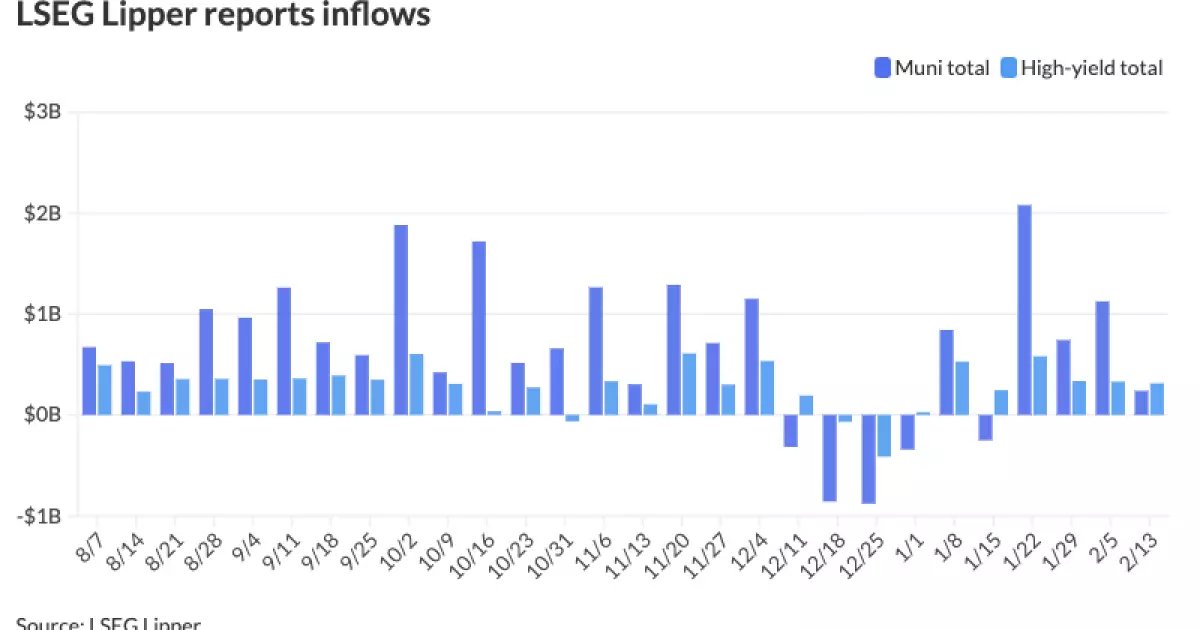The municipal bond market has demonstrated a notable resilience as broader economic conditions evolve, especially in light of the shifts in U.S. Treasury yields and investments trends. With Treasury yields showing a rally and equities enjoying a positive close, municipal bonds firmed up as well, reflecting a robust correlation between these financial products. Notably, the ratios of municipal to Treasury yields reveal a persistent trend where two-year municipal bonds stand at 63%, five-year at 64%, and so forth, indicating a healthy market environment. These figures are crucial for investors looking to gauge risk versus return in a climate that has been characterized by unpredictability and rapid policy changes from Washington.
James Welch, a prominent municipal portfolio manager at Principal Asset Management, has underscored the pivotal role that Washington policies play in shaping demand and performance for municipal bonds, particularly as we approach 2025. The interconnectedess between federal tax policies and monetary strategies implies that investors must remain vigilant. Positive governmental initiatives could spur investment in public projects, while adverse regulations could dampen market zeal. The relative stability of the municipal market, despite challenges like tariff announcements and budget negotiations, showcases its intrinsic ability to absorb shocks and navigate through adversity, creating a compelling case for long-term investment.
Investor sentiment within the municipal bonds landscape appears stronger than ever, as evidenced by consistent inflows into municipal bond mutual funds over the past month. Recent reports suggest a weekly infusion of $238.5 million, following an impressive $1.124 billion from the previous week. Interestingly, high-yield bonds have dominated recent fund flows, attracting a significant portion of new investments. This trend hints at a growing sophistication among investors, who are not merely chasing yields but are actively seeking to allocate funds in a manner that balances risk with anticipated returns.
The upward trajectory in fund flows is attributed, in part, to an expansive market that is recovering from the financial strains of the pandemic era. Issuance of municipal bonds is climbing, currently standing at $50.74 billion year-to-date—a 12.5% increase year-over-year—indicating that issuers are tapping into the bond markets to address a backlog of deferred maintenance and financing needs. Thus, the current atmosphere surrounding the municipal market reflects a strong appetite for risk amid a rising demand for essential public infrastructure improvements.
Despite the buoyancy in fund flows and the supportive issuance environment, issuers are grappling with a reality that federal funding is drying up. This scenario represents both a challenge and an opportunity. For municipal issuers, the decreasing reliance on federal funds will compel them to engage more deeply with bond issuance to meet funding requirements for critical projects. As these projects become even more urgent in light of growing infrastructure needs, the municipal bond market could see further liquidity and demand.
Additionally, the recent changes in the yield curve are an interesting phenomenon worth examining. The recent disinversion on the short end and yields crossing above 3% for the 10-year bonds has the potential to alter the dynamics of investor allocations. A more recognized yield environment may shift some investor preference away from defensive allocations previously inclined toward cash products, thus encouraging a reallocation towards longer-dated municipal bonds as yields remain compelling.
Moreover, looking towards the future of trading in municipal bonds, the integration of technology is fast-tracking the evolution of market operations. Reports indicate that trading activities maintained a robust average daily volume despite a slight retreat from record highs seen in previous years. The proliferation of separately managed accounts (SMAs) and the parallel adoption of electronic trading systems have revolutionized how institutional and retail investors engage with the market.
The increasing embrace of e-trading technologies suggests that they are enabling smaller investors to access previously unattainable asset classes. With e-trading accounting for nearly 18.4% of notional volume traded in recent months, there are indications that automating portfolio management processes will allow for swift adjustments in response to market fluctuations, ensuring that investors can maintain optimal positions with minimal delay.
The municipal bond market stands as a compelling arena for investment, reflecting both resilience and adaptability in a world characterized by economic uncertainty and regulatory variability. Investors are faced with a landscape that demands astute attention to emerging trends, consistent monitoring of federal policies, and an embrace of technological advancements. As the market approaches 2025, the dynamics of municipal bonds will continue to evolve, presenting both challenges and opportunities. With an informed approach, investors can navigate these waters and leverage the potential of municipal bonds to achieve their financial goals.

